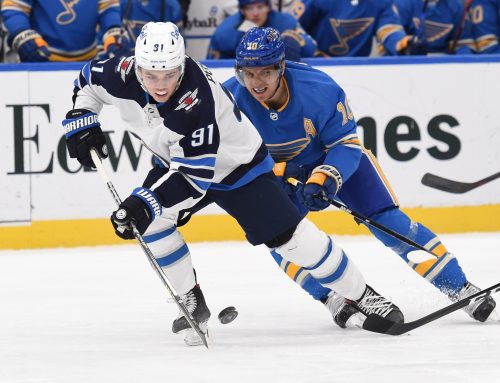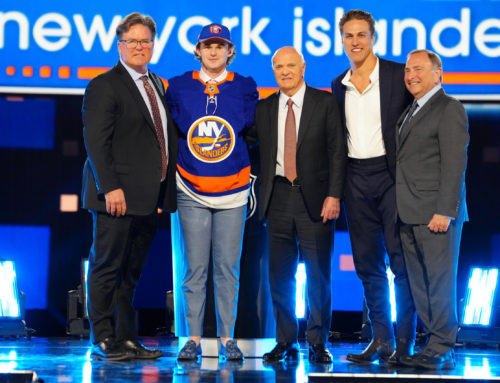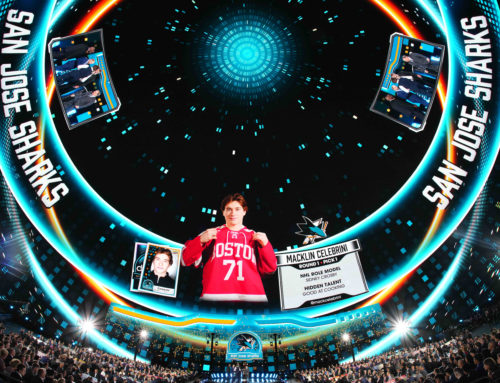The Journey: Faber’s Rookie Results Outstripping Both Makar and Hughes
Ben Gehrels
2024-02-03
Welcome back to The Journey, where we track the development of prospects as they excel in junior, make the NHL, and push towards stardom.
***
With injuries taking down both Connor Bedard (CHI) and Adam Fantilli (CBJ), January's Rookie of the Month Brock Faber (MIN) might just be the new favourite to take home the Calder Trophy in June. Bedard still leads all rookies with 33 points in 39 games (~70-point pace), but Faber's accolades continue to pile up:
- Second in rookie scoring with a 49-point pace.
- Playing almost 25 minutes a night.
- Facing a high quality of competition.
- Currently running Minnesota's PP1.
- Metrics look sustainable.
To contextualize even just the point production, were Faber to maintain this pace for the remainder of the season, here is how he would finish relative to recent rookie defensemen:
- 53 – Quinn Hughes (2019-20) *Calder runner-up
- 50 – Cale Makar (2019-20) *Won Calder
- 50 – Moritz Seider (2021-22) *Won Calder
- 49 – Brock Faber (2023-24)
- 48 – Tyler Myers (2009-10) *Won Calder
- 47 – Zach Werenski (2016-17) *Calder finalist
- 46 – Shayne Gostisbehere (2015-16) *Calder runner-up
- 44 – Rasmus Dahlin (2018-19) *Calder finalist
Wild stuff.
While points are perhaps too heavily weighted when it comes to awarding the league's best first-year player, Faber is clearly performing well enough on that front to deserve serious consideration. His case only becomes stronger when contextual factors and overall impact are taken into account. We will dig into those next and end with a consideration of whether (and how) we could have predicted this level of success for the young man.
***
It took Faber 20 games to receive at least 20% of Minnesota's available power-play time in a single game. In the 29 games since, he has averaged between three and four minutes a night, which works out to 62% of his team's available power-play time. Averaging everything out over his full 49-game sample, he sits at 35.8% on the year.
For reference, the two leading names on that rookie defender list—Cale Makar and Quinn Hughes, probably the two best defensemen on the planet today—averaged 65% and 68% respectively of their teams' PP shares in their rookie years. And unlike Faber, they were both handed the reins to PP1 right away: Makar averaged 57% over his first 20 games and Hughes averaged 61%.
So in other words, Faber has been playing massive catch-up. That 20-game stretch without meaningful time with the man advantage is a significant handicap that he has somehow still been able to overcome to achieve historic production levels. Wowzers.
To stick with this insane comparison for a moment longer, it is also important to note that Faber has been starting fewer than half his shifts (48.3%) in the offensive zone. Contrast that with 62.5% for rookie Makar and 62.8% for rookie Hughes. They were both used primarily as offensive weapons right out of the gate, whereas Faber is being leaned on by his teams to make key stops in the defensive zone.
Faber is further being deployed against a much higher Quality of Competition (QoC) relative to his teammates: he has a QoC rel Corsi For % rating of 0.201, while Makar (0.033) and especially Hughes (-0.0529) were comparatively much more heavily sheltered.
His defensive results are impressive enough on their own; it's the offense that has seemingly caught everyone off guard.
***
Here is Belfry Hockey for a more sophisticated "eye test" take on Faber than I can provide:
"Very few things get me going more than a defenseman who can skate in the D-zone, who can transition defend. Someone who can force stops, get takeaways, and get the play going the other way. This Brock Faber, he's phenomenal, and I just love watching this kid defend. He has outstanding feet. He's got good instincts, he takes good angles, he has an excellent stick. He uses his stick and his feet to get into contact. He forces people to turn, to stop, and then he has an excellent ability to push them into the wall to be able to get that takeaway. Once he has the takeaway, they transition out, and he beats people up the ice. I just love watching this kid defend, and I think that young defensemen, this is really hard to do in the NHL: to force an NHL player to stop, and this kid's doing it every night."
***
Looking under the hood, here are Faber's WAR results (JFresh) and Microstats (All Three Zones).

As Belfry has already pointed out, Faber is posting elite results in terms of successfully exiting the defensive zone with possession and making smart plays with the puck in transition. He lets opposing forwards enter the zone before directing them to the walls and shutting them down.
Once he has possession in the offensive zone, Faber is consistently creating high-danger chances. While there is room for improvement in his shot rates (1.6/game), he is efficient with the shots he does take and has collected a boatload of primary assists—which is part of why his metrics look sustainable: his secondary assist rate of 48% is not propping up his production because he is making plays happen on his own.
***
For fantasy purposes, Faber is already an elite source of Blocks with an average of two per game. His shot and hit rates are only average, but they are easily offset by the scoring (including PPPs) and block rates.
While his two-way prowess and shorthanded usage does leave me slightly concerned that he will follow a path like Seider or Pietrangelo and lose out on offensive opportunities to more one-dimensional PP weapons, it also feels like—as is the case with both those players—that his production will likely have a safe floor (say, 40 points) and that he will be a consistent source of decent peripherals.
***
So. Why did no one see this coming?
People have been high on Faber for years, of course. He arrived in the Wild system courtesy of a trade with the Kings for Kevin Fiala. It was a testament to Faber's reputation that even at the time, when Faber was still a college prospect while Fiala was an established high-end sniper, the trade was generally seen as a fair swap. Minnesota was (and continues to be) in cap hell because of the Suter and Parise buy-outs, so their hand was forced on the Fiala contract. Given the circumstances, receiving Faber in the return was a significant win.
Tooting my own horn for a second, I included Faber in my Top 25 Calder Candidates article for the 2023-24 Dobber Fantasy Hockey Guide back in the summer over hot names like Devon Levi (BUF), Matt Coronato (CGY), Jesper Wallstedt (MIN), Dustin Wolf (CGY), Cutter Gauthier (ANA), and Jimmy Snuggerud (STL).
But I did not forecast anywhere near his current levels of production. Here is the excerpt:
"Can a defenseman win the Calder with under 20 points? Barret Jackman accomplished that feat with St. Louis in 2002-03 on the strength of his nasty defensive play, posting 19 points, 190 penalty minutes, and a plus-23 rating—the latter of which led a team loaded with Hall-of-Famers. Faber is not as edgy or physical as Jackman, but he posted a plus-29 rating with Minnesota (NCAA) this year and plays a responsible suffocating game based on his incredible hockey sense and four-way mobility. He averaged over 20 minutes during his first two games with the Wild and is ready for more."
He certainly was ready for more, and the hockey sense and mobility continue to be the bedrock of his game at the NHL level. But his production at lower levels did not suggest he would ever become a scoring star.

***
Here is my attempt to explain why everyone failed to predict Faber's level of NHL success, and please feel free to weigh in on X or in the comments if you can see something I've missed.
He had time to develop.
I've now written that Calder article for the Guide two years in a row, and it has been a very interesting exercise. The main pattern I have noticed is that for the last five years, Calder winners have been at least 20 years old and playing in at least their Draft+2 campaign: Matty Beniers (D+2), Seider (D+3), Kirill Kaprizov (D+7), Makar (D+3), Elias Pettersson (D+2), and Matt Barzal (D+3).
So while Bedard was the clear-cut favourite to take home top rookie honours this year, he would have flipped the script back to teenagers winning the Calder, which happened consistently between 2011-2017—except for the over-aged Artemi Panarin benefitting from a Connor McDavid injury in 2015-16.
Faber's success is built on his mature, two-way play. Leaving him in college as long as the Wild and Kings presumably gave him an important opportunity to hone the pro-level instincts and habits that we now see on display.
He is a sublime skater with strong two-way instincts.
A few weeks ago after the World Juniors, I wrote about Devils' prospect Leeni Hämeenaho, placing him in a category of players "highlighted by Jimmy Snuggerud and Jiri Kulich: safe-floor players in their draft year who seem very likely to make the NHL because they have many fundamentals vital to thriving in the pro game but seem to lack certain high-end offensive traits who then take a notable step forward in that area in their D+1 to become complete players."
This is a pretty clumsy characterization, of course, and I have only been closely following prospects for a few years, but this type of player increasingly draws my interest. They tend to fall much lower than they should on draft day, and their scouting reports tend to be littered with phrases that complement their defensive awareness, positional play, and/or ability to complement and improve their linemates while also raising questions about their ultimate offensive upside as the next level.
I used to see that "two-way player with limited upside" label as a kiss of death for prospects in terms of fantasy value. But Faber is yet another player whose strong foundational skills and high hockey sense have fueled an offensive explosion once he transitioned to the smarter pro-level game, playing with higher-level teammates.
***
What do you think? How could we have more accurately predicted Faber's success?
***
Thanks for reading! Follow me on X @beegare for more prospect content and fantasy hockey analysis.
One Comment
Leave A Comment
You must be logged in to post a comment.





 BUF
BUF N.J
N.J PHI
PHI MIN
MIN FLA
FLA WPG
WPG VAN
VAN TOR
TOR CGY
CGY S.J
S.J
His actual physical size fits the position and league perfectly. He is big and strong enough to play in the corners and also quick enough to avoid the big hit. He won’t shy away.
Fin.